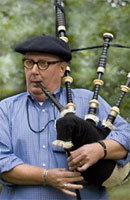|
 |
Subscribe for free home delivery |
|
Our Civility Footprint or - Walk This Way Civility has every bit as much to do with the quality of life here in the biosphere as fossil fuel emissions or ozone depletion, if not more. Are civility emissions as measurable as carbon emissions? Can one measure a civility footprint as we would a carbon footprint? | ||
| by Todd Nelson New column March 1, 2008 |
||
|
According to the metaphor, the goal is to have a small carbon footprint-to walk in a way that reduces our detrimental impact on the planet’s biosphere. A "footprint" is a good metaphor for our individual impact on the social or natural environment. It’s personal, tactile, organic, and immediately comprehensible. It’s elementary: we’re bipeds; we all walk and leave tracks. At my school, the kids in Mr. McWeeny’s science class can calculate the size of their carbon footprint with an online tool, based on heating fuel, car type and annual mileage, electricity use, etc.
What else can be measured in footprints? How about civility-which has every bit as much to do with the quality of life here in the biosphere as fossil fuel emissions or ozone depletion, if not more. It’s not a physical "emission," but, just as with our carbon footprint, civility has a huge effect. In this case, the benefits go up as the size of the footprint increases. And what is that benefit? I used to think that civility just meant, "be nice," like mom used to say. As it turns out there’s a lot more to it-a more global consideration of being nice, attentive, focused, generous, humble, and thoughtful. The trick is measuring the footprint. I recently discovered Choosing Civility by Dr. Piero Massimo Forni. He gives us 25 rules of civility, beginning with "Pay attention."
So, are civility emissions as measurable as carbon emissions? Can one measure a civility footprint as we would a carbon footprint? Well, did you "keep it down, and rediscover silence" today? "Refrain from idle complaints?" Were you "inclusive" today? It’s not hard to add up. So far, there’s no online calculator to determine the size of our civility footprint. But feelings are pretty accurate indicators. And according to this use of the metaphor, we want as large a footprint as possible. They’re big shoes to fill-but we all have big shoes because we each know what we want our "ethosphere" to feel like. It’s not hard to be guided by 25 little rules towards "dishing it out as good as we get." And wherever our own feelings may fall short as guidance, concrete rules add clarity: "Avoid personal questions." "Mind your body." "Accept and give praise." "Don’t Speak Ill."

Got too big a carbon footprint? You can always purchase carbon offsets to compensate the planet for driving that SUV. Just put money into a green company. "Reduce what you can, offset what you can’t," is the motto for carbon offsets, and the going rate is $5.50 per ton of carbon. Buying civility offsets? You’d be offsetting your own health and progress. Not good for us, or for the environment. I hope it never becomes possible to procure civility offsets. But I fear it’s already a tacit mindset at work in our culture. There’s a sense that civility is situational, tradable, an act for certain situations rather than a uniform approach to life; something for the other guy to do better at. "I’ll be good over here; to her; to them, but not to those people." Such offsets would be missing the personal benefit to civility. "Good manners...are also something we do for our own sake," says Dr. Forni in a recent Christian Science Monitor interview. "They are good for us because they help us manage our relationships, which are crucial to our health." Civility is a resource we all possess, and it can be added up pretty easily. There’s a lot at stake. "By keeping the levels of incivility down we keep the levels of violence down," says Forni. "If we teach youngsters in all walks of life how to manage conflict with civility-based relational skills, we will have a less uncivil society, a less violent one." There’s really no excuse for not having a big footprint. A footprint is not necessarily the size of your foot, but where you step and how frequently and how hard. It’s the tracks we make as individuals and a community, and the world needs our big, big feet and careful tracks. Fortunately, where civility is concerned, one size fits all. Price per ton? Inestimable. Chart your own Civility Footprint http://www.adamsschool.com/civilityindex.html Christian Science Monitor article: "Johns Hopkins Civility Project Makes Peace Person to Person, Then Nation to Nation" by Dr. Piero Massimo Forni, Cofounder of Johns Hopkins Civility Project, and a professor of Italian literature. http://www.csmonitor.com/2007/1211/p20s01-ussc.html Choosing Civility: The Twenty-five Rules of Considerate Conduct | ||
|


 Todd R. Nelson has been a public and private school English teacher and administrator for 29 years, in schools in Cambridge, San Francisco, Chicago and Maine. He is principal at the Adams School in Castine, Maine, a 54 student K-8 school on the town common in a little town on the coast, where he gets to play four-square at recess, play his bagpipes, and write musicals for the all-school play.
Todd R. Nelson has been a public and private school English teacher and administrator for 29 years, in schools in Cambridge, San Francisco, Chicago and Maine. He is principal at the Adams School in Castine, Maine, a 54 student K-8 school on the town common in a little town on the coast, where he gets to play four-square at recess, play his bagpipes, and write musicals for the all-school play.